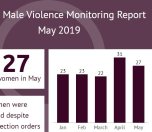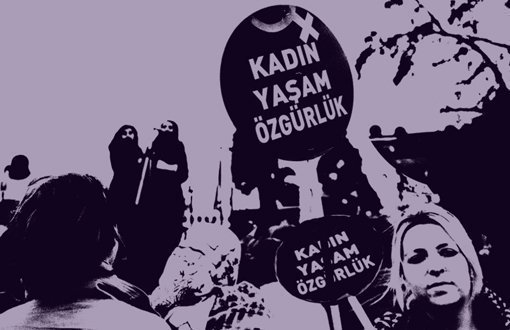Click to read the article in Turkish
Men have killed 25 women and four women’s fathers; one woman’s husband and one woman’s 15-year-old son; raped at least four women; forced 51 women to sex work; harassed 14 women; sexually abused 53 girls; injured 44 women in May.
In May, two of the male violence perpetrators were police officers; two were retired police officers; two were village chiefs and one was private.
In addition to 25 femicides;
Perpetrators of the three women killed in Mersin and Diyarbakır in 2017 were identified. It came to light that the woman and daughter who were killed in Mersin were killed on the pretext of “honor”, and that the 18-year-old woman killed in Diyarbakır was killed by her husband of religious marriage and elder brother.
Three women allegedly committed suicide in Ağrı, Muğla and Mersin. One of the women was forced to have religious marriage, 18 years old and pregnant. Furthermore, one woman attempted suicide in Ağrı.
Men killed at least 97 women and seven children; raped 30 women; harassed 89 women; forced 280 women to sex work; sexually abused 177 girls; injured 185 women in the first five months in 2018.
Two bodies of a pregnant woman aged around 30 and a girl aged between 8-10 were found in Edirne, and body of a woman was found
Homicide
Men killed 25 women in May. Two of the women were pregnant; two babies were born by caesarean section and they survived.
16 percent of the women were killed for attempting to divorce, break up or rejecting the proposal to recommence the romantic relationship.
20 percent of the homicides occurred at public places such as café, in front of school or in the middle of a street. One man killed his wife while she was sleeping. After killing his ex-wife, a police officer claimed that she committed suicide. The murderer who was first released on probation, was arrested then.
48 percent of the women were killed by their husbands or ex-husbands:
One woman was killed by her father; one by her husband of religious marriage; one by her ex-husband; nine by their husbands of official marriage; one by a thief who broke into her house; one by her coworker whose proposal to commence a romantic relationship was rejected; one by her employee; four by their sons; two by people they knew; one by her nephew. Level of perpetrators’ acquaintance with the women weren’t reported in the media in two femicides.
One of the murderers of women was a police officer; one was a retired police officer and one was on his mandatory military service. One murdered was convicted of murder in the past. One murder left prison on permission and one other left the military service on permission and committed murders.
Firearms were used in 52 percent of the murders:
Seven women were killed with knife; two by being slit in throat; one by being thrown down the window; one by being choked with a cable; 12 with gun; one with rifle.
Three men gave themselves after the murders.
Four men committed suicide after the murders; one attempted suicide.
The cities where femicides occurred in May are Adana (1), Ankara (2), Antep (1), Aydın (1), Balıkesir (1), Bursa (6), Denizli (1), Edirne (1), Eskişehir (1), İstanbul (3), Kars (1), Kastamonu (1), Kayseri (1), Manisa (1), Maraş (2) and Yozgat (1).
Rape
Four rape incidents were reported in the media in May.
Two of the rapists were women’s boyfriends; one was domestic employee and was police officer.
One of the rape incidents occurred at a school garden; one in a police vehicle; one at the woman’s home and one at the home where the woman worked as laborer.
Judicial process
Three of the four rapists were arrested. One of these three men was released at the first hearing. No legal action about the rape was taken against one rapist. He was arrested on charge of damaging passport and then released on probation.
Sex work by force
51 women were forced to sex work in five cities in May. 69 percent of the women forced to sex work were not citizens of Turkey.
Judicial process
59 people four of whom were women who forced the women to sex work were detained.
28 perpetrators four of whom were women were arrested.
Harassment
Men harassed at least 14 women in May.
64 percent of the harassers were male strangers:
Seven women were harassed by male strangers, two women by bus drivers, two women by their colleagues, one woman by their manager at workplace and one woman by her ex-boyfriend. The identity of one harasser was not reported in the news.
One of the women subjected to harassment was with disabilities.
Four of the harassment cases occurred at bus, two of them on the street, two of them at workplace, one of them at the metrobus station and one of them at the set of a TV series.
Judicial process
Only two of 10 offenders were arrested. One of these two offenders was arrested after being released on probation twice. Two harassers were released after giving their depositions. One harasser was released by the court pending trial.
A suspension decision was released for another harasser. The judicial processes of two harassers after being detained were not reported in the news. The judicial processes of two other harassers were also not reported
Child abuse
53 girls were sexually abused by men in May.
One of the girls was subjected to forced marriage at an early age. Another girl was married off with a religious ceremony after being threatened by the male abuser. One of the girls was with disabilities.
49 percent of the girls were abused by teachers or school personnel:
One girl was abused by the employer of her family; two girls by their fathers; two girls by shopkeepers; one girl by the father of her husband, with whom she married with a religious ceremony; one girl by her cousin; seven girls by high school directors; one girl by the cleaning worker at school; nine girls by their teachers; eight girls by the drivers of school busses; two girls by their boyfriends; one girl by a man that she met on social media; one girl by the trainer at a sport center; one girl by her friend; one girl by her step-grandfather and 15 girls by male strangers.
One of the offenders was previously imprisoned due to sexual abuse.
Child abuse cases of eight girls were revealed by school counsellors; in two cases, the school management noticed the child abuse; another case was brought to light after the family of the girl got suspicious by her behavior.
Judicial process
According to the news in the media, only six of the 25 offenders were arrested. Four offenders were released on probation; seven offenders were released after giving their depositions; one of the offenders, who is also a high school director, was released by the court pending trial; the judicial processes of three offenders after being detained were not reported in the news. The judicial processes of four offenders were also not reported.
Violence
Men inflicted injury/violence on at least 44 women in May. 16 percent of the women were taken to hospital with serious injuries. One of the women subjected to violence was a trans individual.
Six women were inflicted violence because they wanted to divorce/break up or they refused to reunite. One woman was subjected to violence by the husband of her daughter, whom she wanted to divorce.
32 percent of the violence cases occurred in public places such as the front of courthouses, libraries and streets.
One of the women was inflicted violence despite the suspension decision. One of the women filed a criminal complaint several times, but they were not taken into consideration. The suspension decision released by one woman had just expired. 45 percent of the women were inflicted violence by their partners or ex-partners:
Two women were subject to violence by their fathers; one woman by her husband, with whom she married with a religious ceremony; one woman by her brother; one woman by her ex-son-in-law; four women by their ex-husbands; one woman by her employer; one woman by the male relatives of her brother’s girlfriend; 15 women by their husbands; two women by their neighbors; one woman by the neighborhood mukhtar; four women by their boyfriends; three women by taxi drivers; one woman by her friend; one woman by her step-son and one woman by a male stranger. In five of the violence cases, the degree of affinity between the women and men in question were not reported in the news.
Among the methods of violence were torture, strangling with a cable, setting fire to her house, causing an accident with car and throwing a molotov cocktail to her house:
Men inflicted violence/injury on five women with a knife, six women with a gun and 23 women through battery. They battered two women heavily and threatened them with death; attempted to throw one woman out of the window; threw a molotov cocktail to the house of one woman; set the house of one woman on fire; tortured one woman; strangled one woman with a cable; walked up to another woman and caused one woman to have a car accident.
Judicial process
Seven of the 40 offenders were arrested; no legal actions were launched against two offenders; a decision of suspension was released for three offenders; an investigation was launched against two offenders; three offenders were released by the court pending trial; two offenders were released after being taken into custody.
The judicial processes of six offenders after being detained were not reported in the news. The judicial processes of 13 offenders were also not reported. (ÇT/SD/TK)
ExplanationThe bianet Male Violence Monitoring Report only covers women who lost their lives as a result of male violence. We do not take include any violence cases or crimes that are not gender-based. Throughout the year, we keep track of unidentified murders and suspicious deaths of women in separate monthly tallies but do not add them to the number presented in the headline. At the end of the year, we examine these cases of unidentified murders and suspicious deaths to determine whether the crimes were gender-based. In time, when we come to the conclusion that a crime is gender-base, we include it in the end-of-year tally. We do not include any murders in the reports that are committed by people with psychological disorders (such as murders committed by people with schizophrenia). We include suicide or suicide attempt incidents in the tally only if the woman was subjected to violence/systematical violence in her past. We cover these suicide incidents in a separate category and do not add suicide cases to the number presented in the headline. In addition, we don't include femicide cases that occur in a mass murder in which the woman was not directly targeted under the condition that the debated incident is not gender based either. For example, following case from June 11, 2017 was not included in our male violence report: * A.K. (27), a rancher in Konya province killed his relatives Bekir Kıran (80/male), Mustafa Tokat (80/male), Meryem Tokat (79/female), Hamit Tokat (51/male) and Mehmet Tokat (64/male) with a barreled-gun. He was caught on the way home after committing the murders. It was reported, that A.K. had schizophrenia and considered the villagers responsible for the death of his father, who had lost his life after a heart attack. The occupational groups mentioned in the report, only cover cases in which the occupations have relevance for the act of violence. * Example: "The expression "x% of the rapists were drivers",imply that the woman was raped by the driver of the (public) transportation vehicle she used. |





.jpg)


.jpg)



